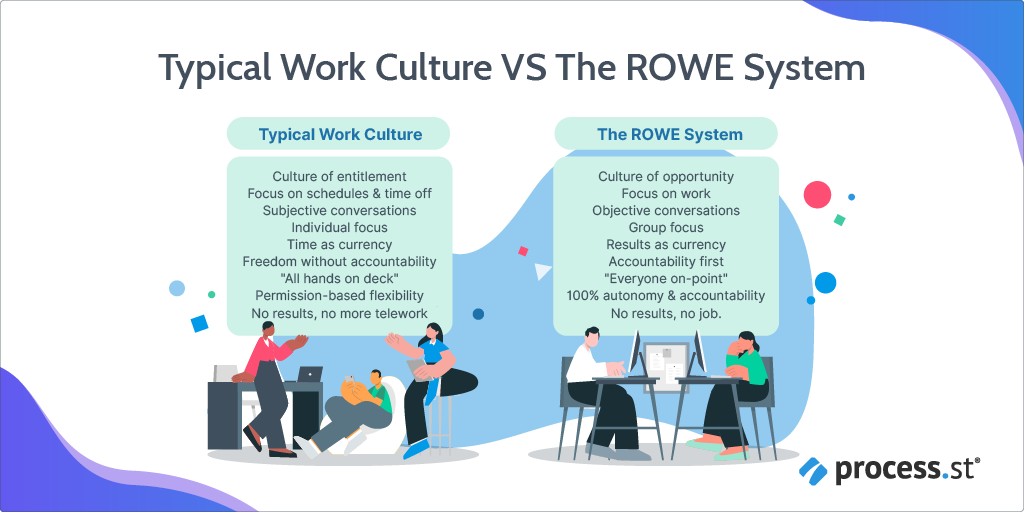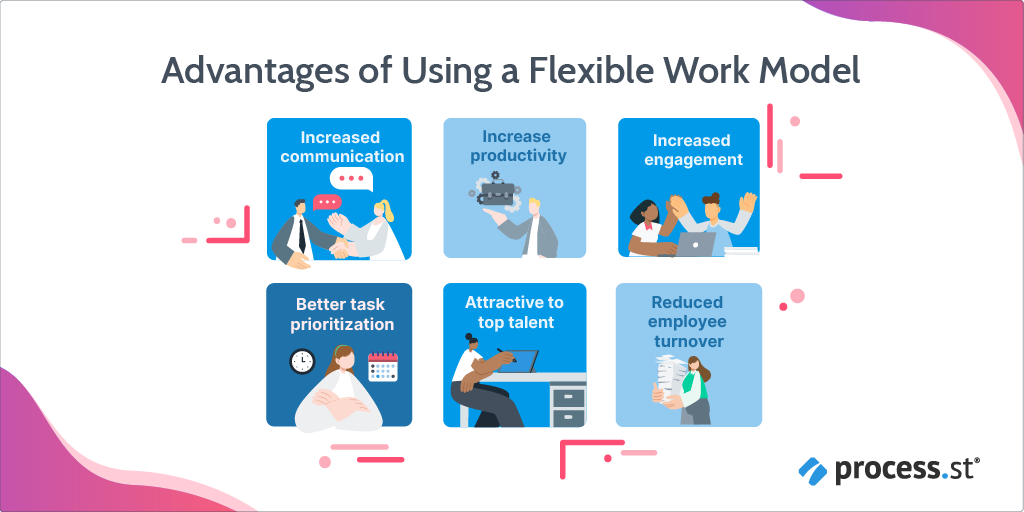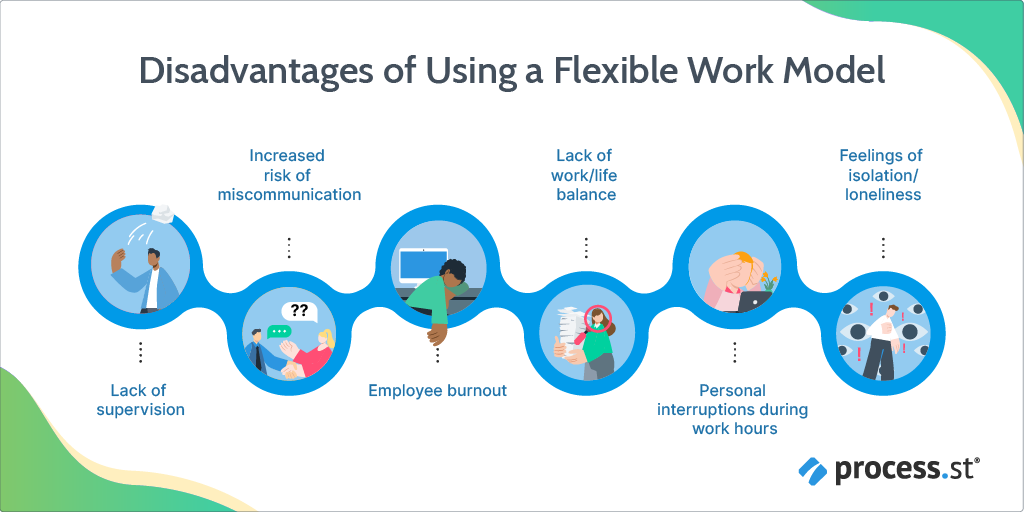
There are many work models these days, and this includes flexible work models.
Choosing the right flexible work model can be daunting – nay, terrifying, even.
There are a string of what-ifs to contend with, and the experts can’t even seem to agree on whether flexible models are more productive than traditional ones. Even employees are divided on which they prefer, so you’re uncertainty is definitely warranted.
That’s okay: With a little creativity and the tips in this Process Street post, you’ll be able to make your work-life work well.
We’ll cover:
- Why are flexible work models important
- Types of flexible work models
- Additional trends in flexible work
- Is a flexible work model right for you?
- Best practices for implementing flexible work models
Let’s get right to it!
Why are flexible work models important?
Flexible work models lack the schedule and location restraints of a traditional work environment. This enables employees to have more control over their lives, leading to a better overall work experience.
Since flexible work models allow employees the freedom to balance their work and personal lives in the best way for them, it can improve mental health, productivity, and engagement.
According to a case study by CIPD, 87% of job seekers want a flexible work arrangement while only 11% of jobs advertise that flexibility. This means that not only could a flexible work model make your current employees happier, but it could also give you an edge when recruiting top talent.
Flexible work models are no longer just for private companies. The increasing level of advancements in data and tech has created more opportunities than ever for public sectors to look into hybrid work models as well. Even government employees are now being offered work-from-home opportunities.
What types of flexible work models can I use?
There are 3 main flexible work models to choose from:
- Compressed workweek
- Location flexibility
- Schedule flexibility
While these 4 models provide a framework for building your own system, you can also combine elements from each, or create your own strategies to find the best solution for your business and your employees.
You also need to be aware that these transitions don’t happen overnight and do typically include some rough patches while everyone settles in. Give it some time before you make another change or reverse your decision entirely.
Change is difficult for everyone and people naturally resist, so implementing a strong change management strategy before you start will reduce the stress and anxiety both you and your employees feel.
With that in mind, let’s take a closer look at these 4 models:
The compressed workweek model
The compressed workweek is the model everyone’s talking about – and the most likely to end in an all-out brawl. People on both sides have very strong opinions on whether a compressed workweek has any benefit at all.
The typical arrangement is a “4×10 schedule”: You work 10-hours 4 days a week, leaving a 3-day weekend. For some employees, the idea of an extended weekend every weekend is convincing enough. For others, 10-hour days are off-putting – either because of the length or other commitments.
You also have to take into consideration the ability to get your work done in 4 days instead of 5. Do you need to coordinate with others who will be working when you aren’t or vice versa? Are there tasks that can only be done on certain days? Will you even be productive at the end of a 10-hour day?
An alternative is a 32-hour week: 8 hours, 4 days a week. This is perhaps the one people are most skeptical about. Is it really possible to get all of the tasks you complete in 40 hours finished to the same quality in 32?
Both have their pros and cons. The compressed workweek can result in:
- Increased stress and pressure;
- More difficulty collaborating with colleagues;
- Bottlenecks caused by team members or managers not being available;
- Lower quality work;
- Loneliness.
However, if managed properly, it can also:
- Same time and costs of commuting;
- Improve employee wellness;
- Higher job satisfaction;
- More time for personal errands;
- More time with children/family.
The flexible location model
Flexible location (or remote work) is a model that allows employees to work from any location. It can also be paired with the flexible schedule model but isn’t always.
Like most flexible work models, flex-location allows employees greater freedom over their workspace. This allows them to work from home, in a park or cafe, or even while traveling. A number of remote workers adopt the “digital nomad” lifestyle, combining their location freedom with their interest in visiting new places.
There are also downsides. Employees may find themselves distracted or interrupted too often while working remotely. There may be technical issues (internet, computers, etc.). Security can also become a serious consideration.
With that said, by utilizing the proper templates, employees can stay productive while working from home, ensuring that the company’s goals are still met.
The flexible schedule model
Flexible scheduling allows employees to set their work schedules around their personal life. This can be great for parents who need to pick up their kids from school or for people who want to take care of a sick family member.
Some of the benefits of flex-time include:
- More time for personal errands or activities;
- Reduced stress since employees can work when they are most productive;
- Increased flexibility for working from home.
Some factors to keep in consideration when adopting a flex-time policy include:
- The company’s business hours;
- How the policy will be communicated and enforced;
- How work will be tracked and measured.
Bonus Work Model: Results Only Environment
A results-only environment (ROWE) combines the best of the 3 primary models into a single strategy.
This is a newer work model that is gaining in popularity. In a ROWE, employees are only evaluated on their results, not the number of hours they spend in the office. This can be great for people who want to take care of their personal lives or have another flexible job outside of their main one.

This model encourages employees to work when and where they are most productive. This can lead to increased creativity and a more positive work-life balance. Tracking the correct data is critical to making this model work.
Just like you’d have KPIs when it comes to your email marketing campaigns, you need to know what KPIs, metrics, and data to track when it comes to employee productivity in a ROWE work model.
When implementing ROWE, you need to determine how you’re going to assess employee performance by looking at metrics such as the:
- Quality of the work;
- Timeliness of the work;
- Number of projects completed.
If you’re thinking of implementing a ROWE, it’s essential to consider tracking employee productivity. It can be challenging to manage and evaluate this model without the correct data.
Additional trends in flexible work
The work models so far have been focused on full-time employees with the desire or ability to continue with your business.
Unfortunately, sometimes that isn’t always the case. A variety of factors in the employee’s life or in your company’s cycle could mean that the employee has to work less – but neither of you wants to break the relationship.
The following 3 models all revolve around retaining and supporting an employee who isn’t able to commit to a full-time workweek.
Job-sharing
Job-sharing is when two employees share the responsibilities of one full-time position. Typically the employees will alternate days although one may choose mornings while the other takes afternoons.
This model allows employees to stay with the company and in the same position, but with more flexibility in their personal time. It’s great for retaining top talent who may otherwise resign because they aren’t able to handle their full responsibilities at the moment.
It’s also worth it to consider job-sharing as your company scales. Certain roles may generate more work than one person can reasonably complete, but not enough to warrant hiring a second full-time role. By dividing those responsibilities among two people sharing the same position, each one will be able to focus on their individual tasks without feeling overwhelmed.
Many companies are now offering job-sharing to attract and retain top talent. These companies find that they can save on benefits costs and that employees are more productive when they are not working long hours.
Having employees with the right skills and experience is critical for successful job-sharing arrangements. Both employees need to work independently and trust each other to do their part.
Sabbaticals
This option is becoming more popular as companies look for ways to retain top talent. In a sabbatical, an employee takes an extended leave of absence (usually six months to a year) and usually receives a reduced salary.
Many companies offer sabbaticals to reward employees for their years of service. This can be a great way to keep talented employees from leaving when something pops up in their personal life, or if the employee simply wants to take advantage of a particular opportunity.
Sabbaticals can be used to pursue postgraduate degrees in their field, live abroad for a period of time, or, again, do all that traveling they’ve been meaning to do.
Whether the motivation is positive or negative, supporting and enabling an employee to pursue what’s important to them fosters increased loyalty and satisfaction. As an extra perk, they’ll have a fresh perspective and likely some new ideas to rejuvenate their old role.
Phased retirement
Retirement can be a stressful transition for employees – and the company as a whole. The employee has to reconfigure their daily schedule without the structure of work, and your company loses a valuable asset with years of knowledge, skills, and abilities hardwired in.
As a result, phased retirement schemes are becoming more and more popular. During phased retirement, employees slowly reduce their hours until their actual retirement date. This eases the employee into retirement, which is obviously good for the employee, but you benefit as well.
You have to replace that employee with someone else. Even if it’s an internal promotion or transfer, the person taking over the role isn’t going to have the same depth of knowledge as your retiring employee.

Using phased retirement, you get the benefit of both working on the same tasks and projects. The new employee is effectively given the methods and insights of their predecessor.
It will also help your other employees adjust. Your new retiree will likely have friendships and relationships with their coworkers, who will be sad to see their colleague leave. They may even doubt the new employee’s ability to do the job properly, which can lead to hostility and low morale.
A phased retirement allows everyone the opportunity to adjust to the new status quo.
Setting the right expectations is critical when implementing a phased retirement program. Employees need to understand how it will work and what they should be doing.
Is a flexible work model right for you?
Flexibility is becoming increasingly important to the modern workforce. Job seekers have the freedom to be very discerning about the companies they work for. You need to offer them something the competition isn’t, and with only that 11% advertising flexibility, it seems like a no-brainer.
Flexible work models aren’t right for everyone, though. Before choosing one you need to carefully consider your company’s needs, your customers’ needs, and your employee’s needs. Is flexible work something you can really afford to do? What are the practicalities, risks, and strategies for implementing these changes?
It’s vital to be aware of both the pros and the cons of flexible work.
The advantages of using a flexible work model

Increased productivity
When employees are allowed to work in a way that best suits them, they are often more productive. This can lead to increased creativity and a more positive work-life balance.
Reduced employee turnover
Employees are more likely to stay with an organization that offers flexible work models. This can lead to a reduction in the cost of recruitment and training.
❤️ Attractive to top talent
Top talent is often looking for workplaces that offer flexibility. If an organization doesn’t provide it, they might find it hard to attract and retain employees, since these employees might be looking for a better work-life balance.
Increased engagement
Employees that contribute to flexible work models tend to be more engaged in their work. More ideas, more involvement in projects, and, ultimately, a better work product come from an increased engagement.
Better task prioritization
Employees who work remotely or have a flexible schedule will have to learn how to prioritize their tasks better. This can be a valuable skill that one can use in the workplace.
️ Increased communication
Communication is critical when employees work in different locations or have flexible schedules. While this can backfire if not properly managed, especially if colleagues work different hours, a deliberate and open communication strategy will help to ensure everyone is on the same page. This can be the result of town hall meetings, all-staff emails, or even a designated Slack channel that is used just for off-topic discussion (read: no work-related talk).
The disadvantages of using a flexible work model

Lack of supervision
When employees are not within eyesight, it can be harder to supervise them. This can lead to a lack of productivity and decreased quality of work.
Increased risk of miscommunication
As mentioned earlier, communication is critical when employees are working in different locations or have flexible schedules. If miscommunication occurs, it can lead to frustration, decreased productivity, and even conflict.
Employee burnout
When employees don’t have set hours or are constantly switching between work and home, they might experience burnout. This can lead to them feeling overwhelmed and stressed out, which will ultimately affect their work performance.
⚖️ Lack of work/life balance
Employees who work from home or have a flexible schedule might find it hard to disconnect from work. This can lead to them feeling like they are always working, which will impact their personal life.
Personal interruptions during work hours
This can be a big issue for employees who work from home. If they are working and have to take care of personal business, it can be hard to focus on their work.
In order to overcome the downsides of flexible work, it’s important for organizations to be aware of them and have a plan in place to mitigate any negative effects.
Best practices for implementing flexible work models
If you’re sure that a flexible work model is right for your organization, you want to make sure you’re fully prepared to guide your company through the transition.
So, here are some key ways to keep your flexible work more flexible :
Do your research
It’s essential to do your research. Look into your company’s policies, processes, culture, and objectives. There may already be a certain amount of flexibility built into your company’s procedures – or flexible work may be totally unfeasible. You need to know this before you get in too deep.
Consider the resources needed
What resources will be needed to set up flexible work for your employees and can you provide it? More importantly, how much will it cost? Depending on your industry, costs may be minimal. Your employees may be able to use their own laptops or existing resources to work from.
However, if that equipment breaks, is lost, or gets stolen, who covers the bill? If it is lost or stolen, how damaging could that be?
Security issues
Let’s go back to the stolen laptop. What security was in place to protect your company? What about your customers? Did that employee have access to sensitive information – or worse, have that information stored on their computer?
When implementing flexible work – especially when employees are using their own equipment outside the office – you need to have a solid security plan in place to reassure all stakeholders that they won’t be put in a vulnerable position.
Cite examples
Look at the models that have worked for other companies of your size and in your industry. What challenges did they face? What could you learn from their experience? How successful were they? Forewarned is forearmed, as they say.
Start with a trial period
If you’re unsure if a flexible schedule is proper for your company, suggest a trial period. Atlassian tried a compressed workweek for 2 months and even wrote an article about it.
In addition to testing the waters, a trial period will also give you a preview of any bottlenecks you’ll face – and what you can do to avoid them – if you choose to go down the flexible work route.
Implement an employee rewards system
Employee engagement relies on company culture, but if no one is working the traditional 40-hour week at their desk in an office, how do you maintain a healthy culture? Employee rewards are one way to do that.
Everyone loves a little recognition for what they do, but when everyone is in on celebrating an achievement, it’s that much better. It’s a great way to connect people who very well might be on completely different sides of the world.
Optimize your processes with dynamic workflows
Finally, having the proper workflow is key to making the most out of a flexible work model. Defining the workflow that will work best for you and your team is essential to a successful remote work setup.
These are some of the key points to follow when establishing the right workflow.
- Use communication tools – Communication tools, such as Slack or Zoom, are essential for remote workers. These tools allow employees to stay in touch and collaborate on projects.
- Set boundaries – It’s important to set boundaries when working remotely. This means setting specific hours you will be working (and conversely, hours where you won’t be working). Having clear boundaries will help reduce the amount of work-related stress you experience.
- Avoid distractions – When working from home, it’s essential to avoid distractions. This means putting away your phone, turning off the TV, and avoiding household chores. By creating a dedicated workspace, you’ll be able to focus on your work and be more productive.
- Take breaks – Working from home can be taxing, both mentally and physically. It’s essential to take breaks throughout the day to recharge. This could mean taking a walk around the block or taking a few minutes to meditate.
Implementing a flexible work policy is a great way to show employees that you value them and want to help them achieve a better work-life balance. The benefits of flexible work models are clear. Organizations that adopt these models will see several positive outcomes, such as increased productivity, reduced employee turnover, and improved morale.
Hanson Cheng is the founder of Freedom to Ascend. He empowers online entrepreneurs and business owners to 10x their business and become financially independent. You can connect with him here.








 Workflows
Workflows Projects
Projects Data Sets
Data Sets Forms
Forms Pages
Pages Automations
Automations Analytics
Analytics Apps
Apps Integrations
Integrations
 Property management
Property management
 Human resources
Human resources
 Customer management
Customer management
 Information technology
Information technology



Leks Drakos
Leks Drakos, Ph.D. is a rogue academic with a PhD from the University of Kent (Paris and Canterbury). Research interests include HR, DEIA, contemporary culture, post-apocalyptica, and monster studies. Twitter: @leksikality [he/him]